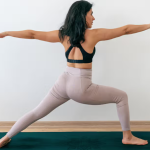In the past few weeks we’ve looked at Iyengar’s principles of commencement, intent endeavour and intimate knowledge. Stage 4 of our journey is consummation.
What Are We Aiming For?
Consummation is a deep communion with yoga at every level: physical, mental, emotional and spiritual — no holds barred. It is mastery of the poses and mastery of oneself. To achieve this takes full-on commitment, and preferably a remote mountain top without piles of laundry waiting to be put on.
This is the ideal, and while there are some great yogis that achieve this supreme state of bliss, most of us are stuck at the commencement and recommencement phase, occasionally putting in a bit of intent endeavour, with the odd flash of intimate knowledge.
But let’s not be put off. There are ways to sample the bliss in our everyday way. So, let’s look at five things we can all achieve, not only in our practice, but also by taking the lessons of yoga off the mat and into our lives.
1. Change Negative To Positive
Yoga is a game of opposites. Where you’d usually slump down, lift up. Where you aim for results, give them up. Where you slacken off, try harder.
So just as you find yourself pushing back to go forward in Child’s Pose (Adho Mukha Vīrāsana), try putting this principle into practice. At the end of the day when you find yourself groaning, for example, “Well, that was a terrible day – I forgot to send a crucial email, my train was delayed, I shouted at the kids,” and so on, try changing the focus. Think about what was actually good in your day, even if it’s the smallest thing.
If we take a peek at Rob in the Beginning Yoga-thon this week, he found the point of his physical limitations and chosen to add days of rest to his schedule. He took that initial feeling of failure, and transformed it into the positive lesson of listening to his body.
2. Embrace The Now
Embrace being where you are. Be in the present moment. It’s not as easy as we think. The present moment is vast and eternal, with unlimited potential. The place where we usually choose to be is half an hour ago: “I wish I hadn’t eaten all those biscuits just before my practice”, or a couple of hours in the future: “I wish I’d saved those biscuits till after the practice…”
While our āsana practice can bring us into the present moment, the practice of prānayāma is another yogic tool you can use. Even if we can fit 5 – 10 minutes of it at the end of the day, it allows us to use the slowing of the breath to set the mind free.
As the spiritual teacher, Eckhart Tolle says:
Realize deeply that the present moment is all you have. Make the NOW the primary focus of your life.
~The Power of Now: A Guide to Spiritual Enlightenment
3. Striking A Balance
We are constantly being told to find balance. In fact, our very lives can feel like one long balancing act: tiptoeing along a high wire, juggling all the different aspects of our lives, while the chasm of failure and nervous breakdown yawns below.
We are told to have a balanced diet, eating only homemade, fresh, organic ingredients — which we sometimes manage, but we quite often don’t. We try to strike a good work/life balance (aren’t we alive at work?) but deadlines call and we end up till stupid o’clock at our desks. And let’s not even start on balancing finances.
So how do we achieve this apparently impossible task of balancing ourselves? The wise yoga teacher, Aadil Palkhivala, says that, “Our personal āsana practice should not be balanced but should balance us.”
He means, if we come to class feeling frazzled, we shouldn’t leave feeling even more broken. Instead we must find a balance to make sure that we end up feeling as whole as possible. Rather than breaking into a sweat and caning our bodies with the rigorous poses, we should practice some self-compassion and maybe find a few more restorative poses.
If we’ve spent all day sitting hunched over a desk, causing our brains to be clogged with a membranous fog of screen glare, we should re-invigorate our bodies with jumping and balancing poses. This will help us head to bed that night for some real rest, rather than lying awake a tired brain but a restless body.
4. Foster Your Mental Freedom
The great blue guru Genie, once asked what his greatest wish would be, said this:
But oh, to be free…Such a thing would be greater than all the magic and all the treasures in all the world.
Freedom is an evocative word. In the yogic tradition it is release from the cycle of life and death. To really be free is to be free of the cycle of reincarnation into human form. To achieve this, the yogi must become enlightened, which is the work of many lifetimes. In our one lifetime, freedom tends to mean being on holiday: a freedom from the daily grind of working, running a home and all the duties that come with responsibility. But is this real freedom?
Real freedom is liberation from bonds, and those bonds are all in the mind. Freedom can be found right here, right now, in liberating ourselves from the voice in our head. This doesn’t mean it stops, but our attachment to those thoughts can stop, and with it, we find that we are as free now as we will ever be.
5. That Is Perfect, This Is Perfect
There is a Sanskrit prayer that goes like this:
That is perfect, this is perfect. Perfect comes from perfect. Take perfect from perfect and the remainder is perfect.
Many of us are perfectionists. Our education has set us up to strive for 100%, to be the best, to try our very hardest. As a result, the concept of failure becomes the dirtiest word in the book.
As yoga practitioners, we perfectionists push ourselves to be that little bit better every class. We try to obey every instruction down to the last millimetre, even if it means we are going cross-eyed with the effort. The little invocation above holds the key to unlocking ourselves from this struggle. It holds the vital knowledge that frees us from our sense of limitation, insecurity and unhappiness.
We are all perfect as we are! Not in a schmaltzy ‘everything is awesome’ way, but in a deep and true way. Our pose now is perfect, just as our pose when we first started on our yoga journey was perfect, and just as (hopefully) our incredibly graceful and frankly intimidating pose will be after many years of practice. It is all about acceptance of where we are now.
…and you are all perfect! As always, thank you for reading and please share your thoughts below, or add to my list if you feel something is missing!













